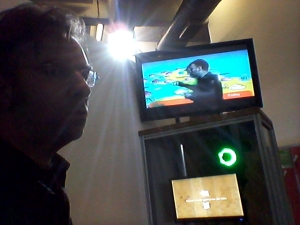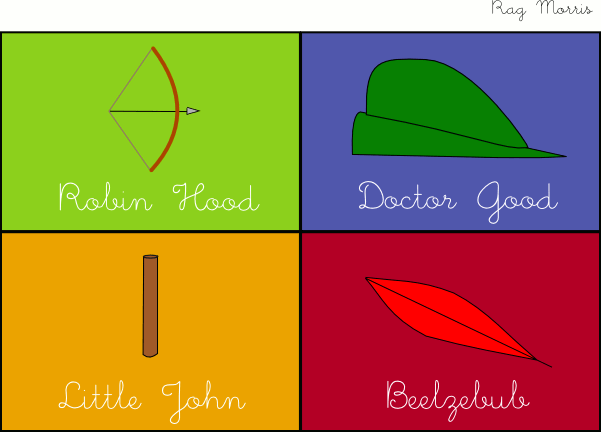In December 2011 Rag Morris Mummers performed a mummers’ play at an event in Henleaze, after which I gave a short talk about the history of mummers’ plays. The time has come for that talk to escape from obscurity in a dusty corner of a hard drive, and for it to get another airing.
Rag Morris Mummers had just performed an interpretation of a traditional mummers play. The script for this play had been recorded in the village of Alveston, which lies to the North-east of Bristol and to the South-west of Thornbury, where it had last been performed around 100 years ago; at least, that was, until the previous Saturday afternoon when we gave it our best shot in the Cross Hands Pub.
And around 100 years ago the mummers of Alveston would not have been alone. Similar groups of men would have been found performing their plays around Bristol, in places like Shirehampton and Kingswood; all around Gloucestershire and Somerset, and in fact in almost every county of England except East Anglia. You’ll have found Galoshins plays in Scotland, plays in Ireland where St Patrick was the hero and St George the villain, and plays like this were found in far flung corners of the world; mummers were renowned troublemakers in parts of Newfoundland, and in Caribbean islands such as St Kitts & Nevis, mummers plays have mixed in with African traditions to produce some quite spectacular hybrid performances.
So the question remains, what were they all doing?
The performances of plays like these were an annual tradition, which formed part of the cycle of the years activities in many villages and towns, which might include events and rituals such as wassailing, May day celebrations, harvest festivals and Hallowe’en, as well as the religious festivals and holidays which they sometimes coincided with.
Folk plays were often performed by groups of men who called themselves mummers, though in different parts of the country you might find groups of soul cakers, Christmas Boys, plough jags or tipteerers; and the plays tended to be performed in the winter, normally in the weeks before Christmas, or between Boxing Day and twelfth night; although some traditions had their seasonal variations; the soul cakers of Cheshire perform around hallowe’en; in Lancashire the Pace Egg plays will appear around Eastertime.
The performers were often working class labourers who wanted to supplement their income over Christmastime to spend on a few treats for the family – shoes for the children, that kind of thing – or just to spend on a few drinks, and the chance of a morsel of roast beef, plum pudding or mince pie. This financial aspect was often high on the agenda; in some cases it was a kind of ritualised begging or busking; it bears comparison with collecting a penny for the Guy on Bonfire night; singing of Christmas Carols door to door, or a tradition of singing around the houses for Hallowe’en, known in some parts of the country as guising or souling. This tradition has crossed the Atlantic and returned to us as Trick or Treating, which doesn’t involve any kind of a performance, which I always think of as a missed opportunity. It may have been that the performance of a Mummers’ play developed as an alternative to the singing of traditional songs, by similar groups of wandering performers.
In common with these traditions, Mumming was often performed inside people’s houses, the bigger the better; sometimes invited, and sometimes not. Perhaps the first thing that the master of the house or the Lord of the Manor would know about it would be a loud knock at the door, then in would come Father Christmas, welcome or welcome not; in costume, and often unrecognisable with a painted face, false beard, a hat covered in ribbons or paper tatters, sometimes completely obscuring his face, asking for “a room, a room to brave gallants all, pray give me room to rhyme!
I am come to show activity this merry Christmas time!” He’d then welcome in the rest of the cast, which could include St George or King George, Bold Slasher or the Turkish Knight, The Doctor, Beelzebub, Little Johnny Jack and so forth.
The performance could be between around 5 and 20 minutes long – the advantage of the shorter performance is that you could fit more houses or pubs in to the day or evening, and make more money; the mummers of Kingswood were known to run between venues; some mummers would spend all day on foot and travel 20 or 30 miles before they’d finish.
So where did this obscure idea originate? Nobody really knows, but it’s probably no more than around 300 years old, there isn’t any evidence for anything of a pre-historic or pagan origin. Influences in the form of the play can be traced in a variety of 18th Century performance styles; from Commedia del’ Arte to Pantomime; which in those days tended to draw on classical stories and Greek myths, featuring characters such as Harlequin and Doctor Faustus, Perseus and Andromeda; as well as travelling shows, including Medicine Shows with Quack Doctors trying to sell their wares, and street performers who often performed from the back of horse-drawn carts and in fairground booths.
An actor called John Edwin recorded in his memoir a variegated street performance which he claimed to have seen in Bristol in 1770; following a dialogue-free re-enactment of the Seige of Troy, depicted as a boxing match between Hector and Achilles which finished with Hector being knocked to the ground by a straight-forward blow there appear the following six lines of dialogue:
O’DRISCOL
A doctor, a doctor, ten pound for a doctor!
{Enter Physician}
PHYSICIAN
Here am I!
O’DRISCOL
What can you cure?
PHYSICIAN
The cramp, the gout, the pain within and the pain without!
O’DRISCOL
O boderation to your nonsense – can you bring a dead man to life again?
PHYSICIAN
Oh marry, that I can – take a little of my tip-tap, put it on your nip-nap, now rise up slasher and fight again.
These lines of dialogue represent one of the earliest occurrences in print of what would become the standard introduction for the doctor in a mummers play; the vast majority of mummers’ plays include a fight between two of the characters, and a doctor arriving to revive a dead or wounded man with some kind of pill or potion.
In fact these plays are often categorised as hero-combat-doctor plays. The characters in the play would vary from place to place, region to region and sometimes year to year; if you look at the archive of original scripts you can find over 700 character names. The figure of King George is quite prominent in some of the early plays, which as they were being performed in the Georgian era would suggest that they were attempting to be topical, many of the lines associated with King George would be given to Saint George in other scripts. Some plays would feature Robin Hood; Rag Morris Mummers performed a script earlier in 2011 based on Robin Hood scripts recorded in villages in Gloucestershire and Oxfordshire; these scripts were obviously based on a ballad first recorded in 1663 featuring Robin Hood and the Bold Tanner, so it’s good to know that the writers of the original scripts were happy to do a bit of copying and pasting. And once the plays were starting to get established the scripts would be printed and reproduced, in chapbooks and pamphlets, as well as in novels and other books; the scripts would get read, performed, forgotten, misremembered, adapted and regurgitated across villages and towns so that eventually each group of mummers would have a script which they considered to be their own.
So the heyday of mummers plays performances in their original form was really the middle of the 19th century; by the early part of the 20th century it was starting to die out, and the final blow came with the first world war, when many of the men who took part in the plays were sent off to the front, and those who did return may not have had the inclination to resuscitate the play without the participation of their fallen comrades, and the whole tradition may not have fitted in to the brave new post-war world they suddenly found themselves in, where everything had changed.
In England today there are only a half dozen groups who can claim a continuous history going back before the Second World War; including the Paper Boys from Marshfield in Gloucestershire.
So what we have today can be thought of as a modern interpretation of a kind of performance that is both a historic tradition and a living tradition; but in most cases is performed by people from an utterly different background from those who would have performed such plays a hundred and fifty years ago; which now might include folk revivalists, morris dancers, street performers, schools and local drama groups as well as people who happen to live in places where a historical Mumming tradition is being nurtured and allowed to thrive; and those different kinds of performers might have all sorts of different reasons for wanting to put on a mummers play.
To generalise, you might find two contrasting views; with some degree of overlap; those who might wish to recreate the same kind of performance that you might have found a couple of hundred years ago, keeping to the same script, sometimes with the same people playing the same characters in the same locations on the same day year after year and even handing the character down from father to son; and those who might want to be a bit more flexible – ad-libbing, adding extra lines of dialogue to make it topical, gradually modifying the script, or even writing new plays which fit within the generic Mumming style. There is room for all these options within the living tradition, and I think that practitioners and aficionados of all kinds of plays have a lot of respect for the variety and quality which can be found in the way different groups across the country perform plays in their own unique style.
Rag Morris have been based at the University of Bristol since the group was founded in 1981 and have been performing traditional and non-traditional mummers’ plays sporadically throughout the last 30 years,
In 1993 there was a large scale production held at Blaise Castle, with a script by Marc Vyvyan-Jones help from Roland & Linda Clare, which told the story of the giants, Vincent and Goram who were responsible for carving out various geographical features around Bristol including the Avon Gorge. One of the characters in the play was called Brunel-zebub and he inspired me to write a new play entitled The Nine Lives of Isambard Kingdom Brunel, which we first performed in 2009 at various Brunel-related sites around Bristol.
At Christmas 2010 we performed at Bristol Zoo with a script I’d written entitled Prince Albert and the Lionheart, which, like the Robin Hood play, kept its source material fairly close to the surface. And in November 2011 we took our Brunel play to Bath, where we performed at the first International Mummers Unconvention, an event which saw a gathering of folk play performers, enthusiasts and researchers meet for a weekend of performances around the city, and a chance to chat about the past, present and future of the mummers play. And I’m sure you’ll agree, the past, present and future is looking decidedly up-beat.
FFI:
www.folkplay.info
www.mummersunconvention.com/


